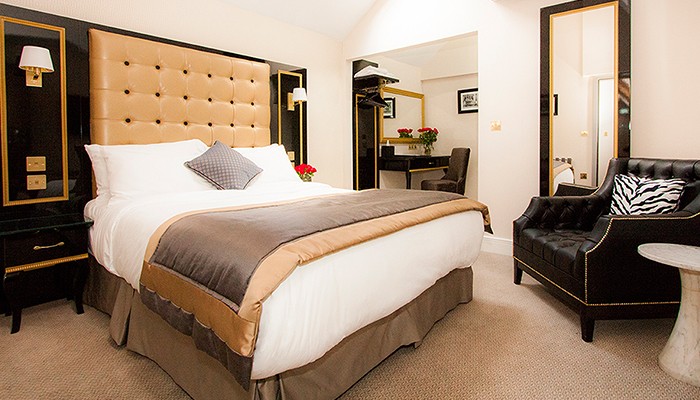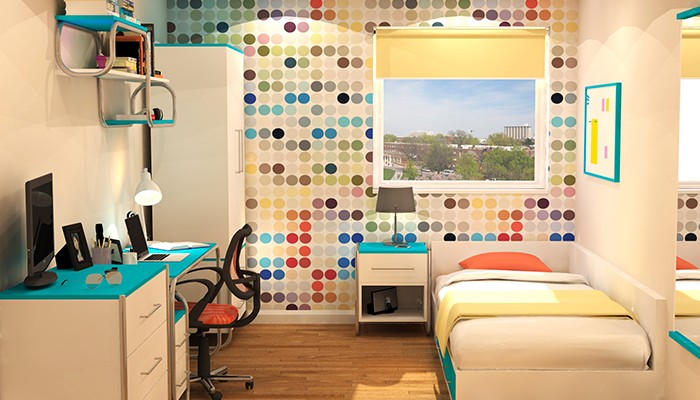REGULATIONS: Casegoods
In the Second of our series looking at the regulations and requirements across each discipline, we look at what a designer needs to know when specifying casegoods, with the assistance of Furnotel.
What are Casegoods?
Casegoods are cabinets and solid panel products typically made from materials such as; wood, metal or plastic. Specifically manufactured for dormitories, bedrooms and public areas
Examples of Casegood Products
1. Bedside units
2. Chest of drawers
3. Desks
4. Wardrobes
5. Console units
6. Lockers
7. Display units
What should a designer know about the difference between domestic and contract specifications?
Currently, there is a disposable mentality to both selecting and purchasing furniture for the domestic home. Homeowners now want to change domestic interiors more frequently as trends come and go. Domestic buyers often resist the temptation to overspend on individual pieces of furniture and due to this shift in buying behaviour, companies such as IKEA tend to be the instinctive choice for so many domestic buyers.
By contrast, furniture which is made for a commercial environment also referred to as contract quality furniture is procured with the intention of remaining in situ for around 10 years, or in some cases even longer.
Hotel bedroom furniture, collectively categorised as casegoods, residential furniture for care homes and universities, is a significant investment for any establishment operator and during the lifespan of the goods, they will be subjected to greater wear and tear than domestic quality furniture. With this in mind, the critical joints and moving parts of the furniture need to be strong enough to withstand the rigours of rough handling and product misuse by occupants across the course of a decade post-refurbishment.
What should the designer consider in relation to durability, fit for purpose?
Most domestic furniture is made from solid woods which may seem on the surface a superior option. However solid timbers are natural products and can warp, crack and house unwanted bugs. Air conditioned hotel bedrooms can also cause solid timber drawers to swell or shrink and subsequently stick over time.
The construction of contract quality casegoods is mainly, medium-density fiberboard (MDF), which are panels made from wood fibres, resin and wax. This is then overlaid with real wood veneer, melamine or laminate. MDF is not only more cost-effective than solid timber but is more durable over time as it does not crack and has a smoother surface to accept finishes.
Contract quality wardrobe doors and cupboards require additional sets of hinges to their domestic counterparts to ensure they do not drop over time. Load bearing shelves for items such as hotel safes or mini bar fridges must have additional concealed fixings to support the additional weight and need to be constructed from a minimum of 18mm thick board. The facing edges of shelving such as this, which will endure considerable bumps and scrapes through constant use, can be reinforced with high impact edging to increase longevity.
Drawers need soft closing contract quality drawer runners to ensure that they will perform well throughout the lifecycle of the product. Drawer bottoms need to be of a solid construction, unlike many domestic drawers which have lightweight bottoms that fail when the drawer is over-loaded with clothes.
Horizontal top surfaces on items such as desks, bedside units or coffee tables are made with high pressure laminate (HPL) to withstand hot plates, cups, straighteners and curling tongs etc. If wooden veneer is opted for, glass is normally applied over the top of the surface to protect the material from these elements which HPL can withstand.
Where glass tops to furniture are required, all glass components should be made from toughened safety glass. Toughened glass, dependent upon its thickness, can be up to five times stronger than regular glass.
Any heavy wall-mounted cabinet casegoods require pattresses in the wall studs and multiple
cross-battening to ensure that the load is evenly spread across the surface of the wall, in order to not pose any potential danger to users over time.
Casegood surface polishes and lacquers need to be both non-toxic and hardwearing.
Are there differences between UK, EU or USA requirements?
Generally, furniture production and construction methods across the EU are largely consistent. In the USA, when MDF is used as the base material for casegoods construction, USA regulations require it to be a low-emission formula MDF as it releases significant amounts of formaldehyde a declared carcinogen.
When communicating with a supplier what should designers be asking?
1. Does the supplier have a quality control mechanism within the company?
2. What project pedigree does the supplier have in the manufacture and supply of casegoods furniture?
3. Over how many years’ experience has the supplier in this field?
4. What testimonials can the supplier provide from similar projects?
5. What is the supplier’s standard drawer-box construction?
6. What is the supplier’s panel fixing methodology? Do they use cams and dowels? Or concealed fixings?
7. How does the supplier package furniture for distribution?
8. What product warranty does the supplier offer? (check disclaimer)
Which requirements are best practice, and which are a legal requirement?
There are few legal requirements, but plenty of best practice initiatives. In essence, the product needs to be “fit for purpose”.
A contract quality table, bedside unit or desk should be able to withstand the weight of an adult with ease without breaking. Moving parts within the casegood design should always be safe for the guest to use. Shelves should be strong enough to take the weight of their intended load and wardrobe hanging rails should be able to withstand the weight of multiple long coats and dresses without bowing.
Standards
Cabinets
BS 4875 Part 7 Level 4 – Strength and stability of furniture. Domestic and contract storage furniture. Performance requirements
Desk and Tables (including glass)
BS EN 15372:2016 – Furniture – Strength, durability and safety. Requirements for non-domestic tables
Upholstery
BS 7176:2007 – Specification for resistance to ignition of upholstered furniture for non-domestic seating by testing composites
BS 7177: 2008 – Specification for resistance to ignition of mattresses, mattress pads, divans and bed bases
BS 5852 (Crib 5) – Methods of test for assessment of the ignitability of upholstered seating by smouldering and flaming ignition sources
Contact Furnotel








